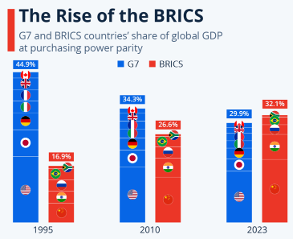BRICS vs. G7: a Tiny Comparison
Last week, the 16th BRICS Summit was held in Kazan, Russia. It was held from October 22nd until 24th and twenty-two heads of state, including Chinese President Xi Jinping and Indian Prime Minister Narendra Modi were present. However, several leaders, such as the presidents of Brazil, Cuba, and Serbia, chose[1] not to attend for various reasons. In comparison, last year’s BRICS summit in Johannesburg attracted over 30 leaders
In 2006, Brazil, Russia, India, and China formed the group known as “BRIC.” South Africa joined in 2010, leading to the name change to “BRICS.” The BRICS is a global alliance uniting major emerging economies. The concept was introduced[1] in 2001 by Jim O’Neill, then chairman of Goldman Sachs, who coined the term. It became a reality in 2006 when Russian President Vladimir Putin initiated a meeting between the leaders of Brazil, Russia, India, and China during the UN General Assembly in New York. By January 1, 2024, the organization expanded to include Iran, Egypt, Ethiopia, and the United Arab Emirates, bringing the total number of member states to nine. Argentina had considered joining but withdrew[2] its application after Javier Milei became president. Meanwhile, over 40 countries have expressed interest in membership, with 15 nations, including Türkiye, Algeria, Kazakhstan, Azerbaijan, and Cuba, formally applying.
BRICS is often seen as an effort to create a geopolitical bloc[3] that can counterbalance the influence of Western-led institutions such as the International Monetary Fund (IMF) and the World Bank. However, the true unity and effectiveness of the BRICS alliance remain subjects of debate. Some observers[4] highlight the significant differences in the political systems, economic structures, and geopolitical interests of the member nations as indicators of the bloc’s potential fragility. However, its influence has been increased, due to their significant economic growth[5] experienced in the last decades. Graph 1 illustrates the shifting economic balance between the G7 and BRICS countries from 1995 to 2023, measured by their share of global GDP at purchasing power parity (PPP). In 1995, the G7 held a dominant 44.9% of global GDP, while BRICS accounted for only 16.9%. Over time, however, BRICS has grown significantly in economic influence. By 2010, the G7’s share had dropped to 34.3%, with BRICS rising to 26.6%. The trend continues in 2023, where BRICS countries hold a larger share of 32.1%, surpassing the G7’s 29.9%. This shift reflects the rapid economic growth of emerging economies such as China and India, positioning BRICS as an increasingly significant force in the global economy. The data indicates a move toward a more multipolar economic world, where the influence of traditional Western powers is balanced by rising economies in the Global South.

Economic importance of BRICS
The participation[1] of over 30 nations at this year’s BRICS Summit in Kazan has drawn significant media attention, with some[2] viewing the turnout as a show of support for Russia from the developing world. However, this should come as no surprise; BRICS offers an appealing alternative governance model for nations seeking options beyond traditional alliances. A new dynamic is emerging[3] in global relations, where Russia’s role as a global player is increasingly viewed separately from its image as an aggressor, distinguishing between war politics and peace diplomacy. While this approach has long been applied to the United States, it is now more openly extended to Russia. The motivations of attending nations are clear: ASEAN members such as Indonesia and Malaysia maintain strong economic ties with China, while Türkiye, a NATO member, seeks greater autonomy. Palestine participated amid the Gaza crisis, and countries such as Bangladesh and Sri Lanka explored alternative financing through the BRICS-led New Development Bank. Venezuela, hindered by U.S. sanctions, found BRICS’ de-dollarization agenda particularly attractive. Notably, both Armenia and Azerbaijan attended[4] despite their ongoing conflict, with Azerbaijan applying for BRICS membership and Armenia seeking foreign investment to boost its economy. It seems that these nations are focused on economics[5] , not ideological politics, and therefore do not particularly pick Putin’s side. BRICS countries aim to counter Western use of financial systems as political leverage. While India remains cautious about reshaping the financial order, the bloc is working to reduce reliance on the U.S. dollar by encouraging trade in local currencies; for example[6] , India and Russia are increasingly using the rupee and ruble in bilateral trade. Although BRICS Pay is still in early stages, there is a shared interest in diminishing Western geo-economic influence.
At this year’s summit, there were discussions about creating a BRICS currency[1] , moving away from reliance on the US dollar, and establishing an alternative to the SWIFT interbank system. However, internal disagreements among members make these proposals challenging. As the group expands, implementing such initiatives may become even more difficult.
Western analysts[2] suggest that the current BRICS summit is aimed at portraying Russia as not being internationally isolated, positioning it as a key global power. Another goal[3] is to reduce the impact of Western sanctions, with Putin expected to advocate for alternatives to the dollar for international payments. However, aside from Iran and North Korea, other countries are unlikely to support this move, as most global banks are not facing issues with the current financial system and would prefer not to align with Russia’s situation.
China at the summit
During the summit, Xi Jinping emphasized[1] the growing importance of reforming the international financial architecture given the current global context. Speaking at the Summit, he also advocated[2] for reinforcing the role of the New Development Bank. The NDB focuses[3] on projects that promote clean energy, transportation, water resources, and urban development, supporting the unique needs of developing regions. Governed with equal voting rights among BRICS members, the NDB has expanded to include countries like Bangladesh, Egypt, and the UAE, reinforcing its goal to foster a multipolar financial world and support economic resilience in the Global South.
Secondly, Xi emphasized[4] that BRICS should actively work towards expanding its membership and establishing partnerships with other nations. He stressed the importance of increasing the representation and influence of developing countries in global governance. In his address at the Summit, Xi highlighted the decision to invite several nations to join as partner countries, calling it a significant milestone in the evolution of BRICS. He encouraged[5] BRICS members to transform the group into a key platform for solidarity and cooperation within the Global South and a leading force in reforming global governance. Xi also emphasized the need for BRICS to promote peace and ensure global security, calling on members to prevent the expansion of conflicts, avoid escalation, and work towards de-escalating the Ukraine crisis. Xi further called on BRICS nations to prioritize innovation and lead efforts in achieving high-quality development. He also urged members to foster sustainability, with China ready to collaborate on green industries, clean energy, and green minerals. Furthermore, Xi has announced[6] that it will implement a capacity-building program for BRICS countries' digital education by creating 10 learning centers in member countries in the next five years, while providing training opportunities for 1,000 local education administrators, teachers and students.
Future of BRICS
As BRICS continues to expand, it faces both significant opportunities and notable challenges. The bloc’s growing membership could amplify its influence on global economic governance[7] and offer a broader range of resources, perspectives, and markets, strengthening its position as a counterbalance to Western-led institutions. However, with diverse political systems, economic priorities, and foreign policy goals among members, achieving cohesion[8] on key issues like currency reform, financial independence, and conflict resolution may become increasingly complex. Internal disagreements—such as India’s cautious stance on reshaping financial systems compared to China and Russia’s proactive approach—could hinder decision-making and the implementation of ambitious projects like a BRICS currency or an alternative to SWIFT. Moreover, as BRICS expands, it may face heightened scrutiny and pushback from Western powers, particularly if its initiatives are seen as a direct challenge to established economic structures. Nevertheless, if BRICS can navigate these challenges and foster greater unity, it has the potential to redefine the global economic landscape and strengthen the voice of developing nations in international affairs.
Sources:
1. BBC News. (2024). *Armenia and Azerbaijan edge closer to peace deal*. Retrieved from https://eurasianet.org/armenia-and-azerbaijan-edge-closer-to-peace-deal
2. BBC News. (2024, October 23). *BRICS summit: What’s on the agenda and will Putin attend?*. Retrieved from https://newsukraine.rbc.ua/news/brics-summit-what-s-on-the-agenda-and-will-1729680676.html
3. BBC News. (2024). *BRICS: Will this alliance reshape the world order?*. Retrieved from https://www.bbc.com/news/articles/cly3ylwg4eqo
4. BBC News. (2024, October 23). *BRICS summit: What's on the agenda and will Putin attend?*. Retrieved from https://newsukraine.rbc.ua/news/brics-summit-what-s-on-the-agenda-and-will-1729680676.html
5. Britannica. (n.d.). *BRICS*. Retrieved from https://www.britannica.com/topic/BRICS
6. China Daily. (2024, October 23). *President Xi Jinping asks BRICS to respond to requests of countries to join bloc*. Retrieved from http://www.chinadaily.com.cn/a/202410/23/WS6718cfd3a310f1265a1c9335.html
7. Diplomat, The. (2024, October). *BRICS summit was a vote of support for global governance reform, not for Russia*. Retrieved from https://thediplomat.com/2024/10/brics-summit-was-a-vote-of-support-for-global-governance-reform-not-for-russia/
8. Economic Times. (2024). *President Xi Jinping asks BRICS to respond to requests of countries to join bloc*. Retrieved from https://economictimes.indiatimes.com/news/international/world-news/president-xi-jinping-asks-brics-to-respond-to-requests-of-countries-to-join-bloc/articleshow/114509451.cms?from=mdr
9. IOL. (2024). *Xi Jinping unveils BRICS digital education plan with 10 learning centers in member countries*. Retrieved from https://www.iol.co.za/news/world/xi-jinping-unveils-brics-digital-education-plan-with-10-learning-centres-in-member-countries-bdf6512e-2b7a-4654-b434-d2164f5d3caf
10. New Development Bank. (n.d.). Retrieved from https://www.ndb.int
11. Statista. (2024). *BRICS and G7 share of global GDP*. Retrieved from https://www.statista.com/chart/30638/brics-and-g7-share-of-global-gdp/
12. Stimson Center. (2023). *The future of BRICS: Between objectives and challenges*. Retrieved from https://www.stimson.org/2023/the-future-of-brics-between-objectives-and-challenges/
13. Trade Brains. (2024). *BRICS to launch new currency: Will it challenge the dominance of the US dollar?* Retrieved from https://tradebrains.in/brics-to-launch-new-currency-will-it-challenge-the-dominance-of-us-dollar/#

